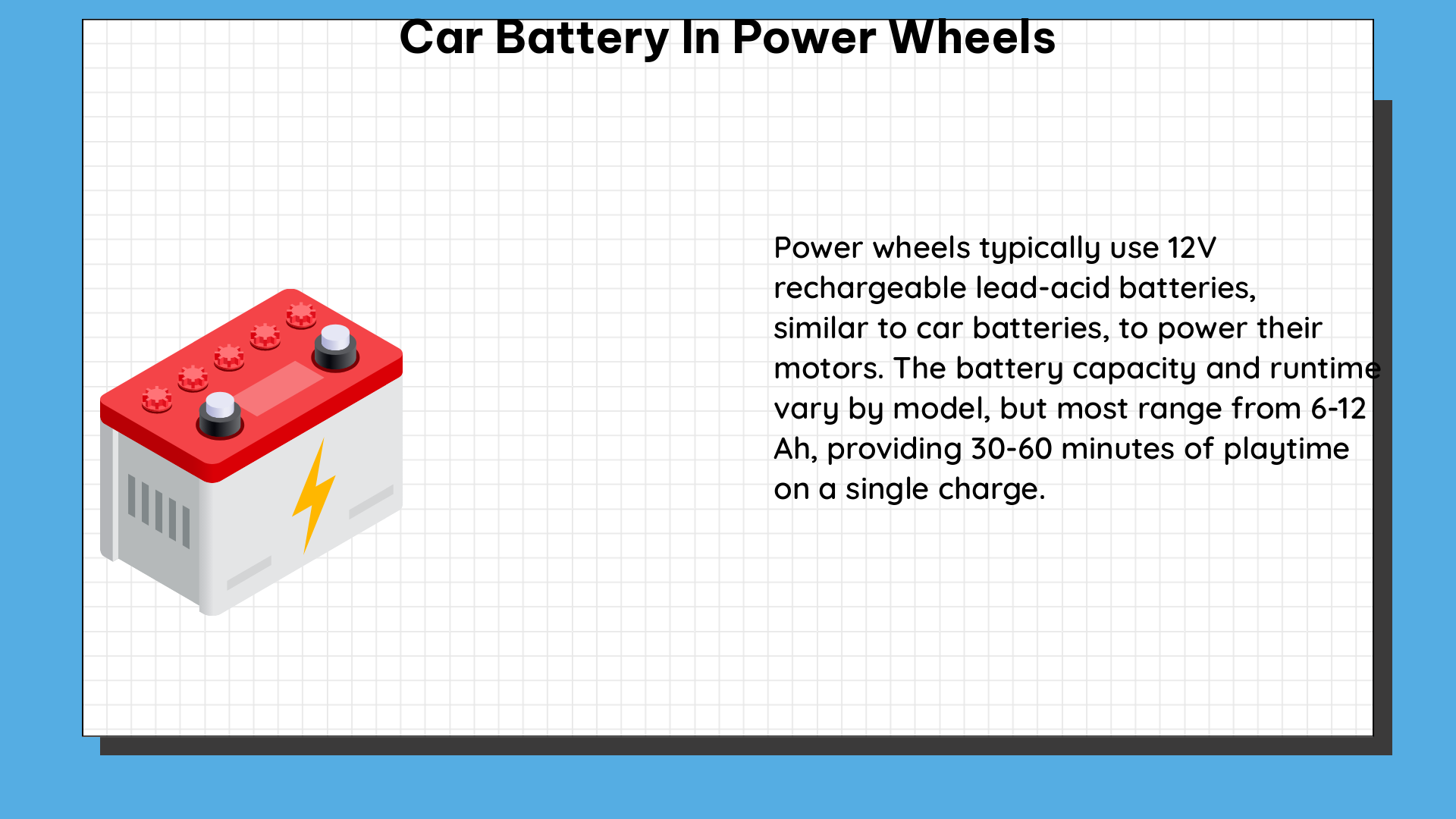Power Wheels are a beloved toy for children, allowing them to experience the thrill of driving their own miniature vehicles. At the heart of these toys lies the car battery, which provides the necessary power to keep the wheels turning. Whether you’re looking to extend the runtime, increase the top speed, or simply replace a worn-out battery, understanding the intricacies of car batteries in Power Wheels is crucial.
Understanding Power Wheels Batteries
Power Wheels typically come equipped with either 6V or 12V lead-acid batteries, similar to those found in small motorized toys or emergency lights. These batteries have a capacity ranging from 9 Ah (ampere-hours) to 12 Ah, which determines the duration of playtime before a recharge is required.
| Battery Voltage | Typical Capacity |
|---|---|
| 6V | 9-12 Ah |
| 12V | 40-60 Ah |
The capacity of the battery is a crucial factor, as it directly impacts the runtime of the Power Wheels. A higher capacity battery will allow for longer playtime before the need for a recharge.
Upgrading to a 12V Car Battery

When considering an upgrade to a 12V car battery, it’s essential to carefully consider the battery’s dimensions, weight, and terminal type. While a typical 12V car battery can have a significantly higher capacity, ranging from 40 Ah to 60 Ah, these batteries are also much larger and heavier than the original Power Wheels battery.
To modify a Power Wheels to run on a 12V car battery, you’ll need to wire the battery in series with the original 6V battery to achieve the required voltage. This can be done using ring terminals, bullet connectors, and a crimping tool. It’s crucial to install a fuse holder for safety reasons, as mentioned in the Instructables guide.
Considerations for 12V Upgrades
- Battery Dimensions: Ensure the 12V battery fits within the Power Wheels’ battery compartment without interfering with the vehicle’s structure or components.
- Battery Weight: The increased weight of a 12V battery can affect the Power Wheels’ handling and performance, potentially causing stability issues or reduced maneuverability.
- Terminal Type: Match the terminal type of the 12V battery with the Power Wheels’ existing wiring to ensure a secure and reliable connection.
- Wiring Modifications: Carefully plan and execute the wiring modifications to connect the 12V battery in series with the original 6V battery, using the appropriate connectors and tools.
- Fuse Installation: Install a fuse holder to protect the electrical system from potential short circuits or overloads, as recommended in the Instructables guide.
Over-Volting Power Wheels
While it’s possible to further increase the voltage of a Power Wheels by over-volting from 12V to 18V, this approach should be approached with caution. Increasing the voltage can put additional strain on the motors and gearboxes, potentially reducing their lifespan.
To mitigate the risks associated with over-volting, it’s recommended to use high-quality aftermarket SLA (Sealed Lead-Acid) batteries with the same Ah rating as the original Power Wheels battery. This ensures even discharge and longer run times without compromising the vehicle’s components.
Considerations for Over-Volting
- Motor and Gearbox Compatibility: Ensure the Power Wheels’ motors and gearboxes can handle the increased voltage without experiencing premature wear or failure.
- Battery Capacity Matching: Use aftermarket SLA batteries with the same Ah rating as the original Power Wheels battery to maintain even discharge and extended runtime.
- Thermal Management: Monitor the Power Wheels for any signs of overheating or excessive heat buildup, as the increased voltage can lead to higher power consumption and thermal stress.
- Safety Precautions: Exercise caution when modifying the electrical system, and always prioritize safety by following proper wiring techniques and installing necessary safety devices, such as fuses.
Conclusion
Upgrading the car battery in Power Wheels can be a rewarding and exciting project, allowing you to extend the runtime, increase the top speed, or simply replace a worn-out battery. By understanding the technical details and considerations involved, you can make informed decisions and safely modify your Power Wheels to suit your child’s needs and preferences.
Remember, safety should always be the top priority when working with electrical systems. Follow the recommended guidelines, use appropriate tools and connectors, and consult with experts if you have any doubts or concerns. With the right approach, you can unlock the full potential of your Power Wheels and provide your child with an even more thrilling driving experience.
References:
- Could I use this 12v car battery in my power wheels?
- Upgrading Power Wheels Batteries: Exploring the Possibilities
- Basic 18v Speed Upgrade for 12v Power Wheels
- Power Wheels Battery Upgrade – 12V to 18V
- Power Wheels Battery Upgrade – 6V to 12V

The lambdageeks.com Core SME Team is a group of experienced subject matter experts from diverse scientific and technical fields including Physics, Chemistry, Technology,Electronics & Electrical Engineering, Automotive, Mechanical Engineering. Our team collaborates to create high-quality, well-researched articles on a wide range of science and technology topics for the lambdageeks.com website.
All Our Senior SME are having more than 7 Years of experience in the respective fields . They are either Working Industry Professionals or assocaited With different Universities. Refer Our Authors Page to get to know About our Core SMEs.